

Ruinous as were the economic results of slavery, the moral effects were no less destructive.

By Dr. Harold Whetstone Johnston
Late Professor of Latin
Indiana University
Growth of Slavery
So far as we may learn from history and legend, slavery was always known at Rome. In the early days of the Republic, however, the farm was the only place where slaves were employed. The fact that most of the Romans were farmers and that they and their free laborers were constantly called from the fields to fight the battles of their country led to a gradual increase in the number of slaves, until they were far more numerous than the free laborers who worked for hire. We can not tell when the custom became general of employing slaves in personal service and in industrial pursuits, but it was one of the grossest evils resulting from Rome’s foreign conquests. In the last century of the Republic all manual labor, almost all trades, and certain of what we now call professions were in the hands of slaves. Not only were free laborers unable to compete with slaves, but every occupation in which slaves engaged was degraded in the eyes of freemen, until all labor was looked upon as dishonorable. The small farms were gradually absorbed in the vast estates of the rich, the sturdy yeomanry of Rome disappeared, and by the time of Augustus the freeborn citizens of Italy who were not soldiers were either slaveholders themselves or the idle proletariate of the cities.
Ruinous as were the economic results of slavery, the moral effects were no less destructive. It is to slavery more than to anything else that is due the change in the character of the Romans in the first century of the Empire. With slaves swarming in their houses, ministering to their luxury, pandering to their appetites, directing their amusements, managing their business, and even educating their children, it is no wonder that the old Roman virtues of simplicity, frugality, and temperance declined and perished. And with the passing of Roman manhood into oriental effeminacy began the passing of Roman sway over the civilized world.
Numbers of Slaves
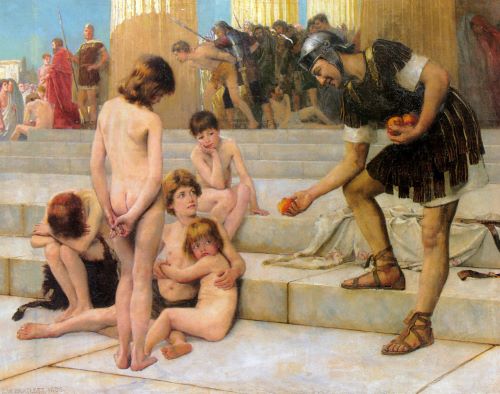
We have almost no testimony as to the number of slaves in Italy, none even as to the ratio of the free to the servile population. We have indirect evidence enough, however, to make good the statements in the preceding paragraphs. That slaves were few in early times is shown by their names: if it had been usual for a master to have more than one slave, such names as Mārcipor, and Ōlipor would not have sufficed to distinguish them. An idea of the rapid increase after the Punic wars may be gained from the number of captives sold into slavery by successful generals. Scipio Aemilianus is said to have disposed in this way of 60,000 Carthaginians, Marius of 140,000 Cimbri, Aemilius Paulus of 150,000 Greeks, Pompeius and Caesar together of more than a million of Asiatics and Gauls.
The very insurrections of the slaves, unsuccessful as they always were, also testify to their overwhelming numbers. Of the two in Sicily, the first lasted from 134 to 132 B.C., and the second from 102 to 98; the last in spite of the fact that at the close of the first the consul Rupilius had crucified 20,000, whom he had taken alive, as a warning to others to submit in silence to their servitude. Spartacus defied the armies of Rome for two years, and in the decisive battle with Crassus (71 B.C.) left 60,000 dead upon the field. Cicero’s orations against Catiline show clearly that it was the calling out of the hordes of slaves by the conspirators that was most dreaded in the city.
Of the number under the Empire we may get some idea from more direct testimony. Horace tells us that ten slaves were as few as a gentleman in even moderate circumstances could afford to own. He himself had two in town and eight on his little Sabine farm, and he was a poor man and his father had been a slave. Tacitus tells us of a city prefect who had four hundred slaves in his mansion. Pliny says that one Caius Caecilius Claudius Isodorus left at his death over four thousand slaves. Athenaeus (170-230 A.D.) gives us to understand that individuals owned as many as ten thousand and twenty thousand. The fact that house slaves were commonly divided into “groups of ten” (decuriae) points in the same direction.
Sources of Supply
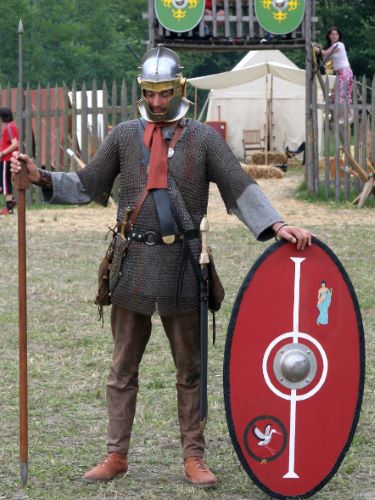
Under the Republic the largest number of slaves brought to Rome and offered there for sale were captives taken in war, and an idea of the magnitude of this source of supply has already been given. The captives were sold as soon as possible after they were taken, in order that the general might be relieved of the trouble and risk of feeding and guarding such large numbers of men in a hostile country. The sale was conducted by a quaestor, and the purchasers were the wholesale slave dealers that always followed an army along with other traders and peddlers. The spear (hasta), which was always the sign of a sale conducted under public authority, was set up in the ground to mark the place, and the captives had garlands on their heads as did the victims offered in sacrifice. Hence the expression sub hastā and sub corōnā vēnīre came to have practically the same meaning.
The wholesale dealers (mangōnēs) assembled their purchases in convenient depots, and when sufficient numbers had been collected marched them to Rome, in chains and under guard, to be sold to local dealers or to private individuals. The slaves obtained in this way were usually men and likely to be physically sound and strong for the simple reason that they had been soldiers. On the other hand they were likely to prove intractable and ungovernable, and many preferred even suicide to servitude. It sometimes happened, of course, that the inhabitants of towns and whole districts were sold into slavery without distinction of age or sex.
Under the Empire large numbers came to Rome as articles of ordinary commerce, and Rome became one of the great slave marts of the world. The slaves were brought from all the provinces of the Empire: blacks from Egypt; swift runners from Numidia; grammarians from Alexandria; from Cyrene those who made the best house servants; from Greece handsome boys and girls, and well-trained scribes, accountants, amanuenses, and even teachers; from Epirus and Illyria experienced shepherds; from Cappadocia the most patient and enduring laborers.
Some of these were captives taken in the petty wars that Rome was always waging in defense of her boundaries, but these were numerically insignificant. Others had been slaves in the countries from which they came, and merely exchanged old masters for new when they were sent to Rome. Others still were the victims of slave hunters, who preyed on weak and defenseless peoples two thousand years ago much as they are said to do in Africa in our own time. These man-hunts were not prevented, though perhaps not openly countenanced, by the Roman governors.
less important source of supply was the natural increase in the slave population as men and women formed permanent connections with each other, called contubernia. This became of general importance only late in the Empire, because in earlier times, especially during the period of conquest, it was found cheaper to buy than to breed slaves. To the individual owner, however, the increase in his slaves in this way was a matter of as much interest as the increase of his flocks and herds. Such slaves would be more valuable at maturity, for they would be acclimated and less liable to disease, and besides would be trained from childhood in the performance of the very tasks for which they were destined. They would also have more love for their home and for their master’s family, for his children were often their playmates. It was only natural, therefore, for slaves born in the familia to have a claim upon their master’s confidence and consideration that others lacked, and it is not surprising that they were proverbially pert and forward. They were called vernae as long as they remained the property of their first master. The derivation of the word is not certain, but it is probable that it has the same origin as Vesta and means something like “born in the house.”
Sale and Prices of Slaves

Slave dealers usually offered their wares at public auction sales. These were under the supervision of the aediles, who appointed the place and made rules and regulations to govern them. A tax was imposed on imported slaves and they were offered for sale with their feet whitened with chalk; those from the east had also their ears bored, a common sign of slavery among oriental peoples. As bids were asked for each slave he was made to mount a stone or platform, corresponding to the “block” familiar to the readers of our own history. From his neck hung a scroll (titulus), setting forth his character and serving as a warrant for the purchaser. If the slave had defects not made known in this warrant the vendor was bound to take him back within six months or make good the loss to the buyer. The chief items in the titulus were the age and nationality of the slave, and his freedom from such common defects as chronic ill-health, especially epilepsy, and tendencies to thievery, running away, and suicide. In spite of the guarantee the purchaser took care to examine the slaves as closely as possible. For this reason they were commonly stripped, made to move around, handled freely by the purchaser, and even examined by physicians. If no warrant was given by the dealer, a cap (pilleus) was put on the slave’s head at the time of the sale and the purchaser took all risks. The dealer might also offer the slaves at private sale, and this was the rule in the case of all of unusual value and especially of marked personal beauty. These were not exposed to the gaze of the crowd, but were offered to those only who were likely to purchase. Private sales and exchanges between citizens without the intervention of a regular dealer were as common as the sales of other property, and no stigma was attached to them. The trade of the mangōnēs, on the other hand, was looked upon as utterly disreputable, but it was very lucrative and great fortunes were often made in it. Vilest of all the dealers were the lēnōnēs, who kept and sold slaves for immoral purposes only.
The prices of slaves varied as did the prices of other commodities. Much depended upon the times, the supply and demand, the characteristics and accomplishments of the particular slave, and the requirements of the purchaser. Captives bought upon the battlefield rarely brought more than nominal prices, because the sale was in a measure forced, and because the dealer was sure to lose a large part of his purchase on the long march home through disease, fatigue, and especially suicide. There is a famous piece of statuary representing a hopeless Gaul killing his wife and then himself. We are told that Lucullus once sold slaves in his camp at an average price of eighty cents each. In Rome male slaves varied in value from $100, paid for common laborers in the time of Horace, to $28,000 paid by Marcus Scaurus for an accomplished grammarian. Handsome boys, well trained and educated, sold for as much as $4,000. Very high prices were also paid for handsome and accomplished girls. The music girls in Plautus and Terence cost their lovers from $500 to $700, but girls of the lowest class sold for as little as $25. It seems strange to us that slaves were matched in size and color as carefully as horses are now, and that a well-matched pair of boys would bring a much larger sum when sold together than when sold separately.
Public and Private Slaves

Slaves were called servī pūblicī and servī prīvātī according as they were owned by the state or by individuals. The condition of the former was considered the more desirable: they were not so likely to be sold, were not worked so hard, and were not exposed to the whims of a capricious master. They were employed to take care of the public buildings and as servants of the magistrates and priests. The quaestors and aediles had great numbers of them in their service, and they were drilled as a corps of firemen to serve at night under the triumvirī nocturnī. Others were employed as lictors, jailers, executioners, etc. The number of public slaves while considerable in itself was inconsiderable as compared with that of those in private service.
Private slaves either were employed in the personal service of their master and his family or were kept for gain. The former, known as the familia urbāna, will be described later. The latter may be classified according as they were kept for hire or employed in the business enterprises of their master. Of these last the most important as well as the oldest class was that of the farm laborers (familia rūstica). Of the others, engaged in all sorts of industries, it may be remarked that it was considered more honorable for a master to employ his slaves in enterprises of his own than to hire them out to others. At the same time slaves could always be hired for any desired purpose in Rome or any other city.
Industrial Employment

It must be remembered that there were practically no freeborn laborers left in the last century of the Republic, and that much work was then done by hand that is now done by machinery. In work of this sort were employed armies of slaves fit only for unskilled labor: porters for the transportation of materials and merchandise, stevedores for the lading and discharging of vessels, men who handled the spade, pickax, and crowbar, men of great physical strength but of little else to make them worth their keep. Above these came artisans, mechanics, and skilled workmen of every kind: smiths, carpenters, bricklayers, masons, seamen, etc. The merchants and shopkeepers required assistants, and so did the millers and bakers, the dealers in wool and leather, the keepers of lodging houses and restaurants, all who helped to supply the countless wants of a great city. Even the professions, as we should call them, were largely in the hands of slaves. Books were multiplied by slaves. The artists who carved wood and stone, designed furniture, laid mosaics, painted pictures, and decorated the walls and ceilings of public and private buildings were slaves. So were the musicians and the acrobats, actors and gladiators who amused the people at the public games. So too, as we have seen, were many of the teachers in the schools, and physicians were usually slaves.
And slaves did not merely perform these various functions under the direction of their master or of the employer to whom he had hired them for the time. Many of them were themselves captains of industry. When a slave showed executive ability as well as technical knowledge, it was common enough for his master to furnish him with the necessary capital to carry on independently the business or profession which he understood. In this way slaves were often the managers of estates, of banks, of commercial enterprises, though these might take them far beyond the reach of their masters’ observation, even into foreign countries. Sometimes such a slave was expected to pay the master annually a fixed sum out of the proceeds of the business; sometimes he was allowed to keep for himself a certain share of the profits; sometimes he was merely required to repay the sum advanced with interest from the time he had received it. In all cases, however, his industry and intelligence were stimulated by the hope of acquiring sufficient means from the venture to purchase his freedom and eventually make the business his own.
The Familia Rustica
Overview
Under this name are comprised the slaves that were employed upon the vast estates that long before the end of the Republic had supplanted the small farms of the earlier day. The very name points at this change, for it implies that the estate was no longer the only home of the master. He had become a landlord, living in the capital and visiting his lands only occasionally for pleasure or for business. The estates may, therefore, be divided into two classes: country seats for pleasure and farms or ranches for profit. The former were selected with great care, the purchaser having regard to their proximity to the city or other resorts of fashion, their healthfulness, and the natural beauty of their scenery. They were maintained upon the most extravagant scale.
There were villas and pleasure grounds, parks, game preserves, fish ponds and artificial lakes, everything that ministered to open air luxury. Great numbers of slaves were required to keep these places in order, and many of them were slaves of the highest class: landscape gardeners, experts in the culture of fruits and flowers, experts even in the breeding and keeping of the birds, game, and fish, of which the Romans were inordinately fond. These had under them assistants and laborers of every sort, and all were subject to the authority of a superintendent or steward (vīlicus), who had been put in charge of the estate by the master.
Farm Slaves

But the name familia rūstica is more characteristically used of the drudges upon the farms, because the slaves employed upon the country seats were more directly in the personal service of the master and can hardly be said to have been kept for profit. The raising of grain for the market had long ceased to be profitable, but various industries had taken its place upon the farms. Wine and oil had become the most important products of the soil, and vineyards and olive orchards were found wherever climate and other conditions were favorable. Cattle and swine were raised in countless numbers, the former more for draft purposes and the products of the dairy than for beef. Sheep were kept for the wool, and woolen garments were worn by the rich and poor alike. Cheese was made in large quantities, all the larger because butter was unknown. The keeping of bees was an important industry, because honey served, so far as it could, the purposes for which sugar is used in modern times. Besides these things that we are even now accustomed to associate with farming, there were others that are now looked upon as distinct and separate businesses. Of these the most important, perhaps, as it was undoubtedly the most laborious, was the quarrying of stone; another was the cutting of timber and working it up into rough lumber, and finally the preparing of sand for the use of the builder. This last was of much greater importance relatively then than now, on account of the extensive use of concrete at Rome.
In some of these tasks intelligence and skill were required as they are to-day, but in many of them the most necessary qualifications were strength and endurance, as the slaves took the place of much of the machinery of modern times. This was especially true of the men employed in the quarries, who were usually of the rudest and most ungovernable class, and were worked in chains by day and housed in dungeons by night, as convicts have been housed and worked in much later times.
The Vilicus
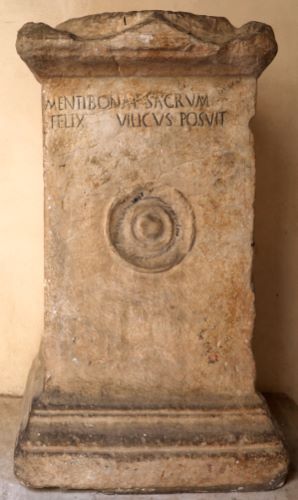
The management of such an estate was also intrusted to a vīlicus, who was proverbially a hard taskmaster, simply because his hopes of freedom depended upon the amount of profits he could turn into his master’s coffers at the end of the year. His task was no easy one. Besides planning for and overseeing the gangs of slaves already mentioned, he had under his charge another body of slaves only less numerous, employed in providing for the wants of the others. Everything necessary for the farm was produced or manufactured on the farm. Enough grain was raised for food, and this grain was ground in the farm mills and baked in the farm ovens by millers and bakers who were slaves on the farm. The task of turning the mill was usually given to a horse or mule, but slaves were often made to do the grinding as a punishment. Wool was carded, spun, and woven into cloth, and this cloth was made into clothes by the female slaves under the eye of the steward’s consort, the vīlica.
Buildings were erected, and the tools and implements necessary for the work of the farm were made and repaired. These things required a number of carpenters, smiths, and masons, though they were not necessarily workmen of the highest class. It was the touchstone of a good vīlicus to keep his men always busy, and it is to be understood that the slaves were alternately plowmen and reapers, vinedressers and treaders of the grapes, perhaps even quarrymen and lumbermen, according to the season of the year and the place of their toiling.
The Familia Urbana
The number of slaves kept by the wealthy Roman in his city mansion was measured not by his needs, but by the demands of fashion and his means. In the early days a sort of butler (ātriēnsis), or major domo, had relieved the master of his household cares, had done the buying, had kept the accounts, had seen that the house and furniture were in order, and had looked after the few servants who did the actual work. Even under the Republic all this was changed. Other slaves, the prōcūrātor and dispēnsātor, relieved the ātriēnsis of the purchasing of the supplies and the keeping of the accounts, and left to him merely the supervision of the house and its furniture. The duties of the slaves under him were, in the same way, distributed among a number many times greater. Every part of the house had its special staff of servants, often so numerous as to be distributed into decuriae, with a separate superintendent for each division: one for the kitchen, another for the dining-rooms, another for the bedrooms, etc.
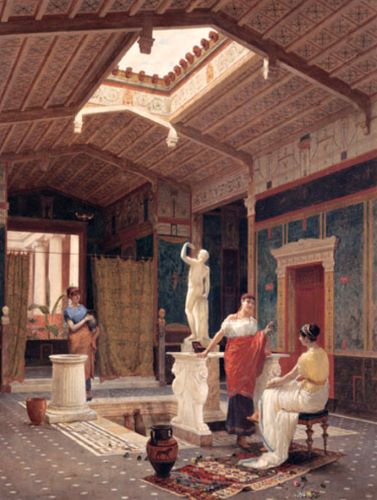
The very entrance door had assigned to it its special slave (ōstiārius or iānitor), who was often chained to it like a watchdog, in order to keep him literally at his post. And the duties of the several sets were again divided and subdivided, each slave having some one office to perform, and only one. The names of the various functionaries of the kitchen, the dining-rooms, and the bedchambers are too numerous to mention, but an idea of the complexity of the service may be gained from the number of attendants that assisted the master and mistress with their toilets. The former had his ōrnātor, tōnsor, and calceātor (who cared for the feet); the latter her hairdressers (ciniflōnēs or cinerāriī) and ōrnātrīx; and besides these each had no less than three or four more to assist with the bath. The children, too, had each his or her own attendants, beginning with the nūtrix, and continuing in the case of the boy with the paedagōgus and pedisequī.
When the master or mistress left the house a numerous retinue was deemed necessary. If they walked, slaves went before to clear the way (anteambulōnēs), and pages and lackeys followed carrying wraps or the sunshade and fan of the mistress, and ready to perform any little service that might be necessary. The master was always accompanied out of the house by his nōmenclātor, who prompted him in case he had forgotten the name of any one who greeted him. If they did not walk, they were carried in litters (lectīcae), something like sedan chairs. The bearers were strong men, by preference Syrians or Cappadocians, all carefully matched in size and dressed in gorgeous liveries. As each member of the household had his own litter and bearers, this one class of slaves made an important item in the family budget. And even when they rode in this way the same attendants accompanied them as when they walked.
When the master dined at the house of a friend his slaves attended him as far as the door at least. Some remained with him to care for his sandals, and others (adversitōrēs) returned at the appointed hour to see him home. A journey out of the city was a more serious matter and called for more pomp and display. In addition to the horses and mules that drew the carts of those who rode, there were mounted outriders and beasts of burden loaded with baggage and supplies. Numerous slaves followed on foot, and a band of gladiators not infrequently acted as escort and bodyguard. It is not too much to say that the ordinary train of a wealthy traveler included scores, perhaps hundreds, of slaves.
Among the familia urbāna must be numbered also those who furnished amusement and entertainment for the master and his guests, especially during and after meals. There were musicians and readers, and for persons of less refined tastes, dancers, jesters, dwarfs, and even misshapen freaks. Under the Empire little children were kept for the same purpose.
Lastly may be mentioned the slaves of the highest class, the confidential assistants of the master, the amanuenses who wrote his letters, the secretaries who kept his accounts, and the agents through whom he collected his income, audited the reports of his stewards and managers, made his investments, and transacted all sorts of business matters. The greater the luxury and extravagance of the house, the more the master would need these trained and experienced men to relieve him of cares which he detested, and by their fidelity and skill to make possible the gratification of his tastes and passions.
Such a staff as has been described belonged, of course, to a wealthy and fashionable man. Persons with more good sense had only such slaves as could be profitably employed. Atticus, the friend of Cicero, a man of sufficient wealth and social position to defy the demands of fashion, kept in his service only vernae, and had them so carefully trained that the meanest could read and write for him. Cicero, on the other hand, could not think it good form to have a slave do more than one kind of work, and Cicero was not to be considered a rich man.
Legal Status of Slaves

The power of the master over the slave, called dominium, was absolute. He could assign him the most laborious and degrading tasks, punish him even unto death at his sole discretion, sell him, and kill him (or turn him out in the street to die) when age or illness had made him incapable of labor. Slaves were mere chattels in the eyes of the law, like oxen or horses. They could not hold property, they could not make contracts, they could testify in the courts only on the rack, they could not marry. The free person in potestāte was little better off legally, but there were two important differences between the son, for example, and the slave. The son was relieved of the potestās on the death of the pater familiās, but the death of the master did not make the slave free. Again, the condition of the son was ameliorated by pietās and public opinion, but there was no pietās for the slave and public opinion hardly operated in his behalf. It did enable him to hold as his own his scanty savings, and it gave a sort of sanction to the permanent unions of male and female slaves called contubernium, but in other respects it did little for his benefit.
Under the Empire various laws were passed that seemed to recognize the slave as a person, not a thing: it was forbidden to sell him for the purpose of fighting with wild beasts in the amphitheater; it was provided that the slave should not be put to death by the master simply because he was too old or too ill to work, and that a slave “exposed” should become free by the act; at last the master was forbidden to kill the slave at all without due process of law. As a matter of fact these laws were very generally disregarded, much as are our laws for the prevention of cruelty to animals, and it may be said that it was only the influence of Christianity that at last changed the condition of the slave for the better.
The Treatment of Slaves
There is nothing in the stern and selfish character of the Roman that would lead us to expect from him gentleness or mercy in the treatment of his slaves. At the same time he was too shrewd and sharp in all matters of business to forget that a slave was a piece of valuable property, and to run the risk of the loss or injury of that property by wanton cruelty. Much depended, of course, upon the character and temper of the individual owner, and Juvenal gives us to understand that the mistress was likely to be more spiteful and unreasonable than the master. But the case of Vedius Pollio, in the time of Augustus, who ordered a slave to be thrown alive into a pond as food for the fish because he had broken a goblet, may be balanced by that of Cicero, whose letters to his slave Tiro disclose real affection and tenderness of feeling. The passionate man nowadays may kill or maim the dog or horse, although it has a money value and he needs its services, and most of us know of worn-out horses turned out upon the common to die. But these things are exceptional, and if we consider the age in which the Roman lived and pass for a moment the matter of punishments, we may say that he was rather pitiless as a taskmaster than habitually cruel to his slaves.
Of the daily life of the town slave we know but little except that his work was light and he was the envy of the drudge upon the farm. Of the treatment of the latter we get some knowledge from the writings of the elder Cato, who may be taken as a fair specimen of the rugged farmer of his time (234-149 B.C.). He held that slaves should always be at work except in the hours, few enough at best, allowed them for sleep, and he took pains to find plenty for his to do even on the public holidays. He advised farmers to sell immediately worn-out draft cattle, diseased sheep, broken implements, aged and feeble slaves, “and other useless things.”
Food and Dress

Slaves were fed on coarse food, but when Cato tells us that in addition to the monthly allowance of grain (about a bushel) they were to have merely the fallen olives, or, failing these, a little salt fish and vinegar, we must remember that this was no less and no worse than the common food of the poorer Romans. Every schoolboy knows that grain was the only ration of the sturdy soldiers that won Caesar’s battles for him. A slave was furnished a tunic every year, and a cloak and a pair of wooden shoes every two years. Worn-out clothes were returned to the vīlicus to be made up into patchwork quilts. We are told that this same vīlicus often cheated the slaves by stinting their allowance for his own benefit, and we can not doubt that he, a slave himself, was more likely to be brutal and cruel than the master would have been.
But entirely apart from the grinding toil and the harshness and insolence of the master and the overseer, the mere restraint from liberty was torture enough in itself. There was little chance of escape by flight. The Greek slave might hope to cross the boundary of the little principality in which he served, to find freedom and refuge under the protection of an adjoining power. But Italy was not cut up into hostile communities, and should the slave by a miracle reach the Rubicon or the sea, no neighboring state would dare defend him or even hide him from his Roman master. If he attempted flight, he must live the life of an outlaw, with organized bands of slave hunters on his track, with a reward offered for his return, and unspeakable tortures awaiting him as a warning for others. It is no wonder, then, that vast numbers of slaves sought rest from their labors by a voluntary death. It must be remembered that many of them were men of good birth and high position in the countries from which they came, some of them even soldiers, taken on the field of battle with weapons in their hands.
The Peculium

We have seen that the free man in potestāte could not legally hold property, that all that he acquired belonged strictly to his pater familiās. We have also seen that he was allowed to hold, manage and use property assigned to him by the pater familiās, just as if it had been his own. The same thing was true in the case of a slave, and the property was called by the same name (pecūlium). His claim to it could not be maintained by law, but was confirmed by public opinion and by inviolable custom. If the master respected these, there were several ways in which an industrious and frugal slave could scrape together bit by bit a little fund of his own, depending in great measure, of course, upon the generosity of his master and his own position in the familia.
If he belonged to the familia rūstica, the opportunities were not so good, but by stinting himself he might save something from his monthly allowance of food, and he might, perhaps, do a little work for himself in the hours allowed for sleep and rest, tilling, for example, a few square yards of garden for his own benefit. If he were a city slave there were besides these chances the tips from his master’s friends and guests, and perhaps a bribe for some little piece of knavery or a reward for its success. We have already seen that a slave teacher received presents from his pupils. It was no uncommon thing either, as has been said, for a shrewd master to teach a slave a trade and allow him to keep a portion of the increased earnings which his deftness and skill would bring. More rarely the master would furnish the capital and allow the slave to start in business and retain a portion of the profits.
For the master the custom was undoubtedly profitable in the long run. It stimulated the slave’s energy and made him more contented and cheerful. It also furnished a means of control more effective than the severest corporal punishment, and that without physical injury to the chattel. To the ambitious slave the pecūlium gave at least a chance of freedom, for he hoped to save enough in time to buy himself from his master. Many, of course, preferred to use their earnings to purchase little comforts and luxuries nearer than distant liberty. Some upon whom a high price was set by their owners used their pecūlium to buy for themselves cheaper slaves, whom they hired out to the employers of laborers already mentioned. In this way they hoped to increase their savings more rapidly. The slave’s slave was called vicārius, and legally belonged to the owner of his master, but public opinion regarded him as a part of the slave-master’s pecūlium. The slave had a life interest only in his savings, that is, they did not pass to his heirs on his death, for a slave could have no “heirs,” and he could not dispose of them by will. If he died in slavery his property went to his master. Public slaves were allowed as one of their greatest privileges to dispose of one-half of their property by will.
At the best the accumulation of a sum large enough to buy his liberty was pitifully slow and painful for the slave, all the more because the more energetic and industrious he was, the higher the price that would be set upon him. We can not help feeling a great respect for the man who at so great a price obtained his freedom. We can sympathize, too, with the poor fellows who had to take from their little hoards to make to the members of their masters’ families the presents that were expected on such great occasions as the marriage of one of them, the naming of a child, or the birthday of the mistress.
Punishments
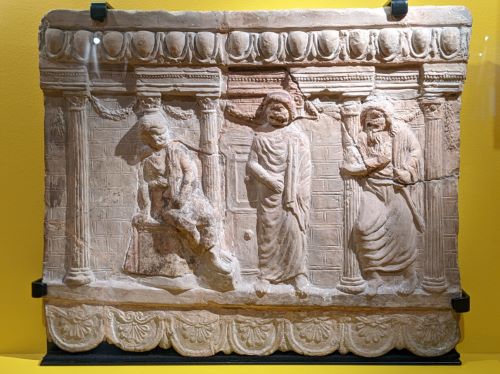
It is not the purpose of the following sections to catalogue the fiendish tortures sometimes inflicted upon slaves by their masters. They were not very common and were no more characteristic of the ordinary correction of slaves than lynching and whitecapping are characteristic of the administration of justice in Georgia and Indiana. Certain punishments, however, are so frequently mentioned in Latin literature, that a description of them is necessary in order that the passages in which they occur may be understood by the reader.
The most common punishment for neglect of duty or petty misconduct was a beating with a stick or flogging with a lash. If the picture of a Roman school gives a correct idea of the punishments inflicted upon a schoolboy with the consent of his parents, we should expect that of a slave to be as severe as regard for his usefulness afterwards would permit. Hence we find that for the single rod or stick was often substituted a bundle of rods, usually elm (ulmī) corresponding to the birch of England and the hickory of America. For the lash or rawhide (scutica or lōrum) was often used a sort of cat-o’-nine-tails, made of cords or thongs of leather. When the offense was more serious, bits of bone were attached to this, and even metal buttons, to tear the flesh, and the instrument was called a flagrum or flagellum. It could not have been less severe than the knout of Russia, and we may well believe that slaves died beneath its blows. To render the victim incapable of resistance he was sometimes drawn up to a beam by the arms, and weights were even attached to his feet, so that he could not so much as writhe under the torture.
In the comedies are many references to these punishments, and the slaves make grim jests on the rods and the scourge, taunting each other with the beatings they have had or deserve to have. Sometimes the rods are parasites, who shave close the person to whom they attach themselves; sometimes they are pens, the back of the culprit being the copybook; sometimes they are catapults, dealing darts and death. Sometimes the victim is a bottomless abyss of rods; sometimes he has absorbed so much essence of elm that he is in danger of himself becoming a tree; sometimes he is an anvil; sometimes he is a solid melting under the blows; sometimes he is a garden well watered by blows. Sometimes an entertainment is being prepared scot-free for his back; and sometimes his back is a beautifully embroidered carpet.
Another punishment for offenses of the same trivial nature resembled the stocks of old New England days. The offender was exposed to the derision of his fellows with his limbs so confined that he could make no motion at all, could not so much as brush a fly from his face. Variations of this form of punishment are seen in the furca and in the “making a quadruped out of a man.” The latter must have been something like the “bucking and gagging” used as a punishment in the militia; the former was so common that furcifer became a mere term of abuse. The culprit carried upon his shoulders a log of wood, shaped like a V, and had his arms stretched out before him with his hands fastened to the ends of the fork. This log he had to carry around in order that the other members of the familia might see him and take warning. Sometimes to this punishment was added a lashing as he moved painfully along.
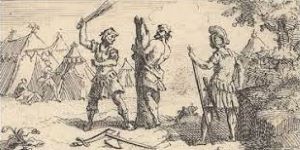
Less painful and degrading for the moment, but far more dreaded by the slave, was a sentence to harder labor than he had been accustomed to perform. The final penalty for misconduct on the part of a city slave, for whom the rod had been spoiled in vain, was banishment to the farm, and to this might be added at a stroke the odious task of grinding at the mill, or the crushing toil of labor in the quarries. The last were the punishments of the better class of farm slaves, while the desperate and dangerous class of slaves who regularly worked in the quarries paid for their misdeeds under the scourge and in heavier shackles by day and fewer hours of rest by night. These may be compared to the galley slaves of later times. Those utterly incorrigible might be sold for gladiators.
For actual crimes, not mere faults or offenses, the punishments were far more severe. Slaves were so numerous and their various employments gave them such free access to the person of the master, that his property and very life were always at their mercy. It was indeed a just and gentle master that did not sometimes dream of a slave holding a dagger at his throat. There was nothing within the confines of Italy so much dreaded as an uprising of the slaves. It was simply this haunting fear that led to the inhuman tortures inflicted upon the slave guilty of an attempt upon the life of his master or of the destruction of his property. The Romans had not learned twenty centuries ago, as some of our own citizens have not yet learned, that crimes are not lessened by increasing the sufferings of the criminals.
The runaway slave was a criminal: he had stolen himself. He was also guilty of setting a bad example to his fellow slaves; and, worst of all, runaway slaves always became bandits and they might find a Spartacus to lead them. There were, therefore, standing rewards for the capture of fugitīvī, and there were men who made it their business to track them down and return them to their masters. The fugitīvus was brought back in shackles, and was sure to be flogged within an inch of his life and sent to the quarries for the rest of his miserable days. Besides this, he was branded on the forehead with the letter F, for fugitīvus, and sometimes had a metal collar riveted about his neck. One such has the inscription:
FUGI. TENE ME. CUM REVOCAVERIS ME D. M. ZONINO, ACCIPIS SOLIDUM.
I have run away. Catch me. If you take me back to my master Zoninus you’ll be rewarded.
For an attempt upon the life of the master the penalty was death in its most agonizing form, by crucifixion. This was also the penalty for taking part in an insurrection, witness the twenty thousand crucified in Sicily and the six thousand crosses that Pompeius erected along the road to Rome, each bearing the body of one of the survivors of the final battle in which Spartacus fell. And the punishment was inflicted not only upon the slave guilty of his master’s life, but also upon the family of the slave, if he had wife and children. If the guilty man could not be found, his punishment was made certain by the crucifixion of all the slaves of the murdered man. Tacitus tells us that in the reign of Nero four hundred slaves were executed for the murder of their master, Pedianus Secundus, by one of their number undetected.
The cross stood to the slave as the horror of horrors. The very word (crux) was used among them as a curse, especially in the form ad (malam) crucem. The various minor punishments were inflicted at the order of the master or his representative by some fellow slave called for the time carnifex or lōrārius, though these words by no means imply that he was regularly or even commonly designated for the disagreeable duty. Still, the administration of punishment to a fellow slave was felt to be degrading, and the word carnifex was apt to attach itself to such a person and finally came to be a standing term of abuse and taunt. It is applied to each other by quarreling slaves, apparently with no notion of its literal meaning, as many vulgar epithets are applied to-day. The actual execution of a death sentence was carried out by one of the servī pūblicī at a fixed place of execution outside of the city walls.
Manumission

The slave might purchase his freedom from his master by means of his savings, as we have seen, or he might be set free as a reward for faithful service or some special act of devotion. In either case it was only necessary for the master to pronounce him free in the presence of witnesses, though a formal act of manumission often took place before a praetor. The new-made freedman set proudly on his head the cap of liberty (pilleus), often seen on Roman coins. He was now called lībertus in reference to his master, lībertīnus in reference to others; his master was no longer dominus, but patrōnus. The relation that now existed between them was one of mutual helpfulness.
The patron assisted the freedman in business, often supplying the means with which he was to make a start in his new life. It the freedman died first, the patron paid the expenses of a decent funeral and had the body buried near the spot where his own ashes would be laid. He became the guardian of the freedman’s children, or if no heirs were left, he himself inherited the property. The freedman was bound to show his patron marked deference and respect on all occasions, to attend him upon public occasions, to assist him in case of reverse of fortune, and in short to stand to him in the same relation as the client had stood to the patron in the brave days of old.
The Clients
Overview
The word cliēns (from clueō; therefore “hearer,” “one who obeys”) is used in Roman history of two very different classes of dependents, who are separated by a considerable interval of time and may be roughly distinguished as the Old Clients and the New. The former played an important part under the Kings, and especially in the struggles between the patricians and plebeians in the early days of the Republic, but had practically disappeared by the time of Cicero. The latter are first heard of after the Empire was well advanced, and never had any political significance. Between the two classes there is absolutely no connection, and the student must be careful to notice that the later is not a development of the earlier class.
The Old Clients

Clientage (clientēla) goes back beyond the founding of Rome to the most ancient social institutions of the Italian communities. The gentēs who settled on the hills along the Tiber had brought with them as a part of their familiae numerous free retainers, who seem to have farmed their lands, tended their flocks, and done them certain personal services in return for protection against cattle thieves, raiders, and open enemies. These retainers were regarded as inferior members of the gēns to which they had severally attached themselves, had a share in the increase of the flocks and herds (pecūlia), and were given the clan name, but they had no right of marriage with persons of the higher class and no voice in the government. They were the original plēbs, while the gentīlēs were the populus of Rome.
Rome’s policy of expansion soon brought within the city a third element, distinct from both gentīlēs and clientēs. Conquered communities, especially those dangerously near, were made to destroy their own strongholds (oppida) and move in mass to the city. Those who possessed already the gentile organization were allowed to become a part of the populus, or governing body, and these, too, brought their clientēs with them. Those who had no such organization either attached themselves to the gentēs as clients, or preferring personal independence settled here and there, in and about the city, to make a living as best they might. Some were possessed of means as large perhaps as those of the patricians; others were artisans and laborers, hewers of wood and drawers of water; but all alike were without political rights and occupied the lowest position in the new state. Their numbers increased rapidly with the expansion of Roman territory, and they soon outnumbered the patricians with their retainers, with whom, of course, as conquered people they could have no sympathies or social ties. To them also the name of plēbs was given, and the old plēbs, the clientēs, began to occupy an intermediate position in the state, though politically included with the plebeians. Many of them, owing perhaps to the dying out of ancient patrician families, gradually lost their dependent relation and became identified in interests with the newer element.
Mutual Obligations
The relation between the patrician patrons and the plebeian clients is not now thoroughly understood; the problems connected with it seem beyond solution. We know that it was hereditary and that the great houses boasted of the number of their clients and were eager to increase them from generation to generation. We know that it was regarded as something peculiarly sacred, that the client stood to the patron as little less than a son. Vergil tells us that a special punishment in the underworld awaited the patron who defrauded a client. We read, too, of instances of splendid loyalty to their patrons on the part of clients, a loyalty to which we can only compare in modern times that of Highlanders to the chief of their clan. But when we try to get an idea of the reciprocal duties and obligations we find little in our authorities that is definite. The patron furnished means of support for the client and his family, gave him the benefit of his advice and counsel, and assisted him in his transactions with third parties, representing him if necessary in the courts. On the other hand the client was bound to advance the interests of his patron in every possible way. He tilled his fields, herded his flocks, attended him in war, and assisted him in special emergencies with money.
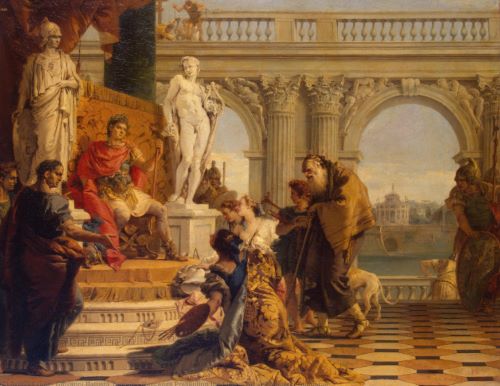
It is evident that the mutuality of this relation depended solely upon the predominant position of the patron in the state. So long as the patricians were the only full citizens, so long, that is, as the plebeians had no civil rights, the client might well afford to sacrifice his personal independence for the sake of the countenance and protection of one of the mighty. In the case of disputes over property, for example, the support of his patron would assure him justice even against a patrician, and might secure more than justice were his opponent a plebeian without another such advocate. It is evident, too, that the relation could not long endure after the equalization of the orders. For a generation or two the patron and the client might stand together against their old adversaries, but sooner or later the client would see that he was getting no equivalent for the service he rendered, and his children or his children’s children would throw off the yoke. The introduction of slavery, on the other hand, helped to make the patron independent of the client, and while we can hardly tell whether its rapid growth was the cause or the effect of declining clientage, it is nevertheless significant that the new relation of patrōnus and lībertus marks the disappearance of that of patrōnus and cliēns in the old and better sense of the words.
The New Clients
The new clients need not detain us long. They came in with the upstart rich, who counted a long train of dependents as necessary to their state as a string of high-sounding names, or a mansion crowded with useless slaves. These dependents were simply obscure and needy men who toadied to the rich and great for the sake of the crumbs that fell from their tables. There might be among them men of perverted talents, philosophers or poets like Martial and Statius, but they were all at best a swarm of cringing, fawning, time-serving flatterers and parasites. It is important to understand that there was no personal tie between the new patron and the new client, no bond of hereditary association. No sacrifice was involved on either side. The client did not attach himself for life to one patron for better or for worse; he frequently paid his court to several at a time and changed his masters as often as he could hope for better things. The patron in like manner dismissed a client when he had tired of him.
Duties and Rewards
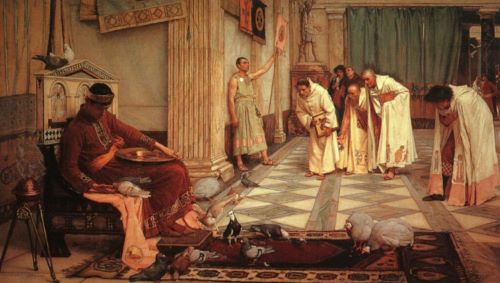
The service, however mean and degrading, was easy enough. The chief duty was the salūtātiō: the clients arrayed in the toga, the formal dress for all social functions, assembled early in the morning in the great man’s hall to greet him when he first appeared. This might be all required of them for the day, and there might be time to hurry through the streets to another house to pay similar homage to another patron, perhaps to others still, for the rich slept late. On the other hand the patron might command their attendance in the house or by his litter, if he was going out, and keep them at his side the whole day long. Then there was no chance to wait upon the second patron, but every chance to be forgotten by him. And the rewards were no greater than the services. A few coins for a clever witticism or a fulsome compliment; a cast-off toga occasionally, for a shabby dress disgraced the levee; or an invitation to the dinner table if the patron was particularly gracious.
One meal a day was always expected, and felt to be the due of the client. But sometimes the patron did not receive and the clients were sent empty away. Sometimes, too, after a day’s attendance the hungry and tired train were dismissed with a gift of cold food distributed in little baskets (sportulae), a poor and sorry substitute for the good cheer they had hoped for. From these baskets the “dole,” as we should call it now, came to be called sportula itself, and in the course of time an equivalent in money, fixed finally at about thirty cents, took the place of this. But it was something to be admitted to the familiar presence of the rich and fashionable, there was always the hope of a little legacy, if the flattery was adroit, and even the dole would enable one to live more easily than by work, especially if one could stand well with several patrons and draw the dole from each of them.
The Hospites
Overview
Finally we come to the hospitēs, though these in strictness ought not to be reckoned among the dependents. It is true that they were often dependent on others for protection and help, but it is also true that they were equally ready and able to extend like help and protection to others who had the right to claim assistance from them. It is important to observe that hospitium differed from clientship in this respect, that the parties to it were actually on the footing of absolute equality. Although at some particular time one might be dependent upon the other for food or shelter, at another time the relations might be reversed and the protector and the protected change places.
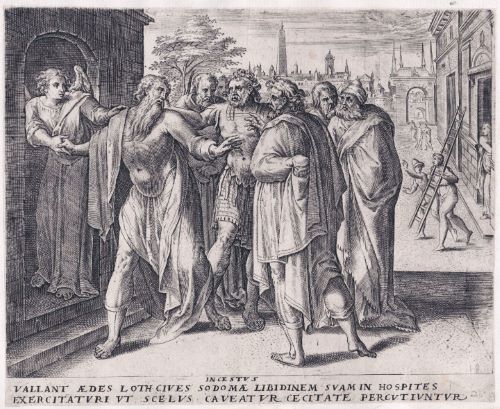
Hospitium, in its technical sense, goes back to a time when there were no international relations, to the time when stranger and enemy were not merely synonymous words, but absolutely the same word. In this early stage of society, when distinct communities were numerous, every stranger was looked upon with suspicion, and the traveler in a state not his own found it difficult to get his wants supplied, even if his life was not actually in danger. Hence the custom arose for a man engaged in commerce or in any other occupation that might compel him to visit a foreign country to form previously a connection with a citizen of that country, who would be ready to receive him as a friend, to supply his needs, to vouch for his good intentions, and to act if necessary as his protector. Such a relationship, called hospitium, was always strictly reciprocal: if A agreed to entertain and protect B, when B visited A’s country, then B was bound to entertain and protect A, if A visited B’s country. The parties to an agreement of this sort were called hospitēs, and hence the word hospes has a double signification, at one time denoting the entertainer, at another the guest.
Obligations of Hospitium
The obligations imposed by this covenant were of the most sacred character, and any failure to regard its provisions was sacrilege, bringing upon the offender the anger of Iuppiter Hospitālis. Either of the parties might cancel the bond, but only after a formal and public notice of his intentions. On the other hand the tie was hereditary, descending from father to son, so that persons might be hospitēs who had never so much as seen each other, whose immediate ancestors even might have had no personal intercourse.
As a means of identification the original parties exchanged tokens tesserae hospitālēs, (see Rich and Harper, s. v.), by which they or their descendants might recognize each other. These tokens were carefully preserved, and when a stranger claimed hospitium his tessera had to be produced and submitted for examination. If it was found to be genuine, he was entitled to all the privileges that the best-known guest-friend could expect. These seem to have been entertainment so long as he remained in his host’s city, protection including legal assistance if necessary, nursing and medical attendance in case of illness, the means necessary for continuing his journey, and honorable burial if he died among strangers. It will be noticed that these are almost precisely the duties devolving upon members of our great benevolent societies at the present time when appealed to by a brother in distress.
Chapter 5 from The Private Life of the Romans, by Harold Whetstone Johnston (1903), published by Project Gutenberg to the public domain.


